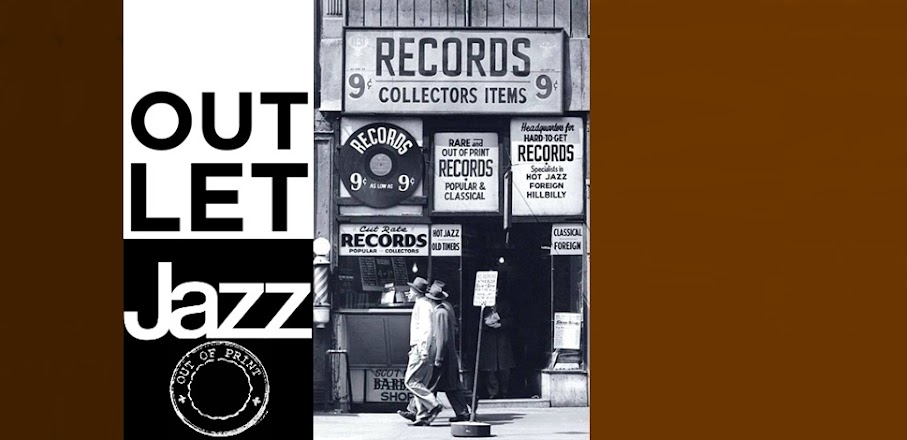Recording engineer and producer Mack Emerman formed Criteria Records in Miami, Florida, in 1957. He had just moved to Miami, himself and having been a jazz trumpeter he wanted to work with jazz musicians. He was impressed with the work of Rudy Van Gelder and sought to achieve a similar sound. He formed Criteria Studios the following year. Criteria Records released five titles by 1960, when the label folded. However, Criteria Studios went on to become the most successful studio in Miami, recording over 250 gold or platinum hit records by such aritsts as Eric Clapton, The Eagles, Aerosmith, AC/DC, The Bee Gees, Crosby Stills and Nash, Fleetwood Mac, Chicago and many many more. Today it is The Hit Factory at 1755 NE 149th Street.
V.S.O.P. Records has released the only four jazz recordings that came out on Criteria Records and OUTLET JAZZ will present them in the next four posts...
The Lon Norman Octet
"The Octet"
Gold Coast Jazz
(Volume 1)
This is the first recording released on Criteria and the fourth of several VSOP releases of Criteria recordings. Criteria was a small jazz label by Mack Emerman that showcased Miami jazz musicians of the late 1950's. Hundreds of gold, platinum, and diamond singles and albums have been recorded, mixed or mastered at Criteria, for many notable artists and producers.
All Criteria LPs are extremely rare and highly sought after. This 1957 recording exemplifies the high caliber of jazz that made it onto this label. The Octet played straight ahead West Coast style jazz in the Shorty Rogers, Marty Paich manner. The arrangements by Lon Norman are excellent. The solos by Berry Poger, Marvin Marvin, Eddie Gralka and Jerry Marshall are top notch. This is very fine music, and compares most favorably with Hollywood sessions of the day. *magnebit.xeran.com*
This was the first recording released on the Criteria label in 1957. While The Octet was modeled on the Dave Pell Octet, Lon Norman's arrangements were totally original. This stereo recording puts on display Miami's finest musicians of the time, including Bill Ladley, Jerry Marshall, Eddie Gralka, Marvin Marvin, Berry Poger, Paul Sarmento, Joe Black & Frank DeFabio. Criteria founder Mac Emerman, who produced and engineered this date, went on to become a legendary recording engineer and studio owner. This session sounds and feels like it was recorded in Hollywood. The musicians are no slouches and the charts are excellent. *ccmusic.com*
When you blend two ingredients such as Lon Norman's drive to create new dimensions in ensemble sound, and Mack Emerman's imaginative organizational skills, the result could well illustrate the heights to which modern jazz music can be carried. And this is Mack Emerman's dream: to harness the skill and talent of Miami music on Criteria records, and to weld these creative elements into a powerful musical force. Perhaps the lush fertility of tropical Florida combined with Yankee-style skill and inventiveness, can provide the seeds for a new modern sound that must be reckoned with by the jazz — the Gold Coast Sound.
One point we should like to strongly make, if we haven't made it so far, is the fact that the Octet and this album are truly a cooperative effort. We must pay tribute to the following wonderful guys who are part of all this. They are LON NORMAN, of course, who is the cohesive force behind all of this, for it is Lon's arranging, his musical directorship, his fine trombone playing that are the true highlights of this album. *Val Machen (liner notes)*
1 - Saturday Comes 'Round
(Lon Norman)
2 - Don't Blame Me
(Jimmy Mchugh)
3 - Potsdam
(Lon Norman)
4 - Blue Moon
(Rodgers, Hart)
5 - If I Should Lose You
(Rainger, Robin)
6 - Dark Horse
(Lon Norman)
7 - Scott Free
(Lon Norman)
Lon Norman (trombone); Jerry Marshall (trumpet); Berry Poger (alto sax, tenor sax, flute);
Eddie Gralka (baritone sax, tenor sax); Marvin Marvin (tenor sax);
Joe Black [#1, #2, #3, #6, #7], Frank DeFabio [#4, #5] (pianos);
Paul Sarmento (bass); Bill Ladley (drums).
Recorded at Criteria-Reela Studios, Miami, Florida, August 1957




















